牛津深圳版英语七年级上册 Module 2 The natural worldUnit 3 The earth 知识点导学案
文档属性
| 名称 | 牛津深圳版英语七年级上册 Module 2 The natural worldUnit 3 The earth 知识点导学案 |
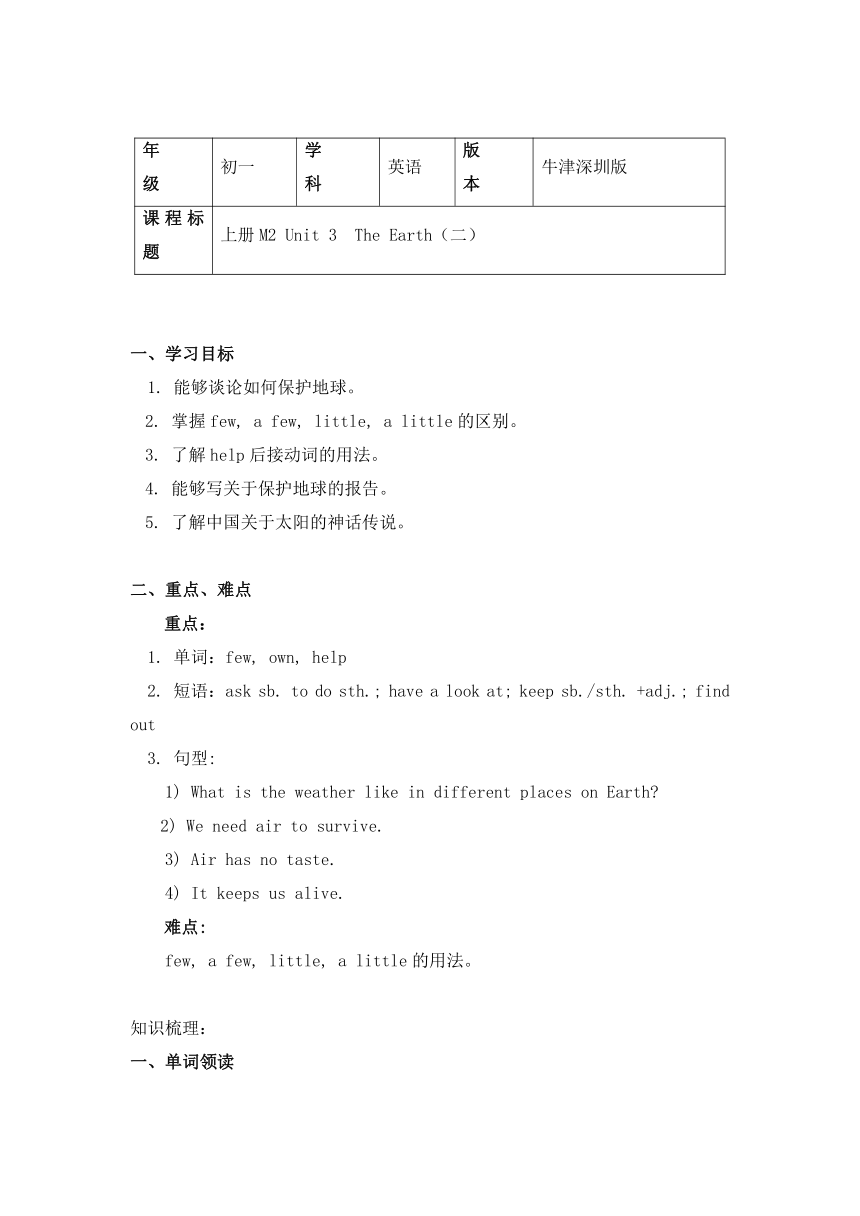
|
|
| 格式 | doc | ||
| 文件大小 | 478.0KB | ||
| 资源类型 | 教案 | ||
| 版本资源 | 牛津深圳版 | ||
| 科目 | 英语 | ||
| 更新时间 | 2020-09-11 14:52:02 | ||
图片预览

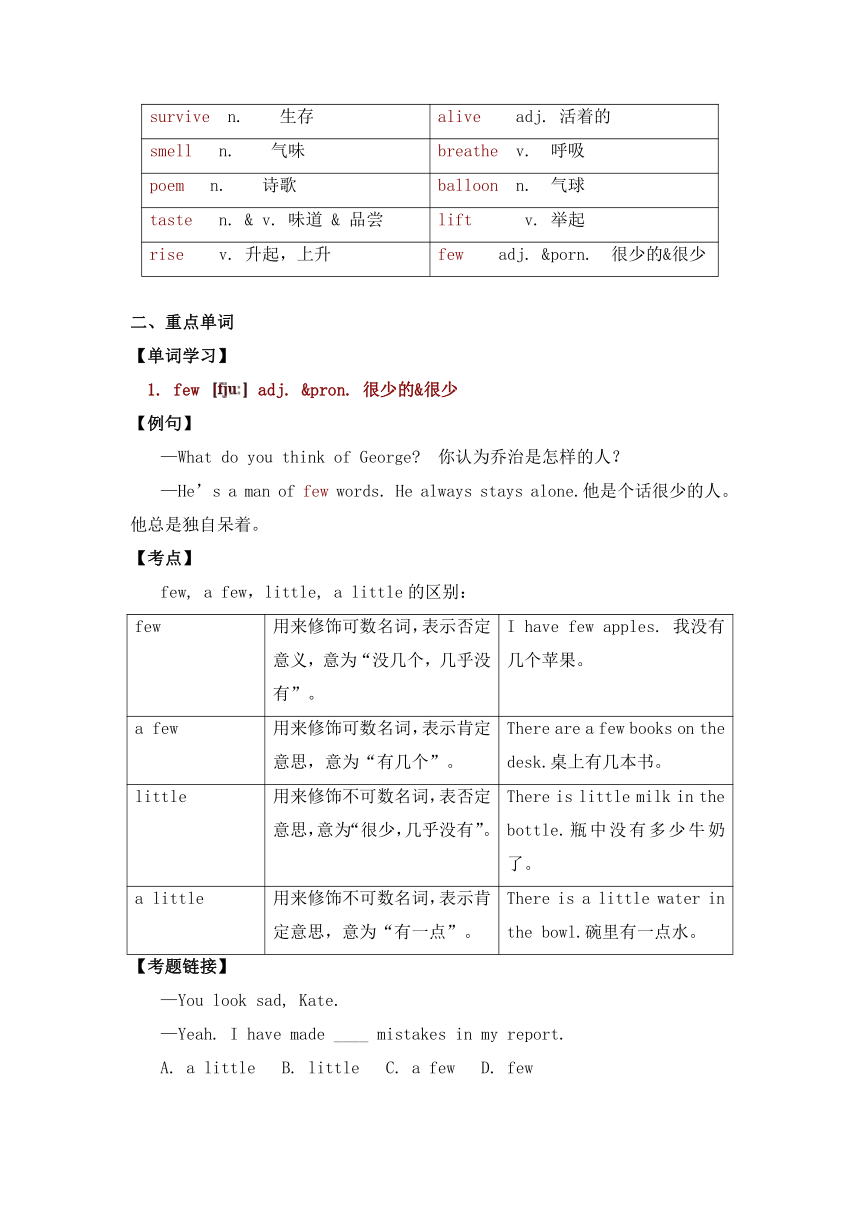
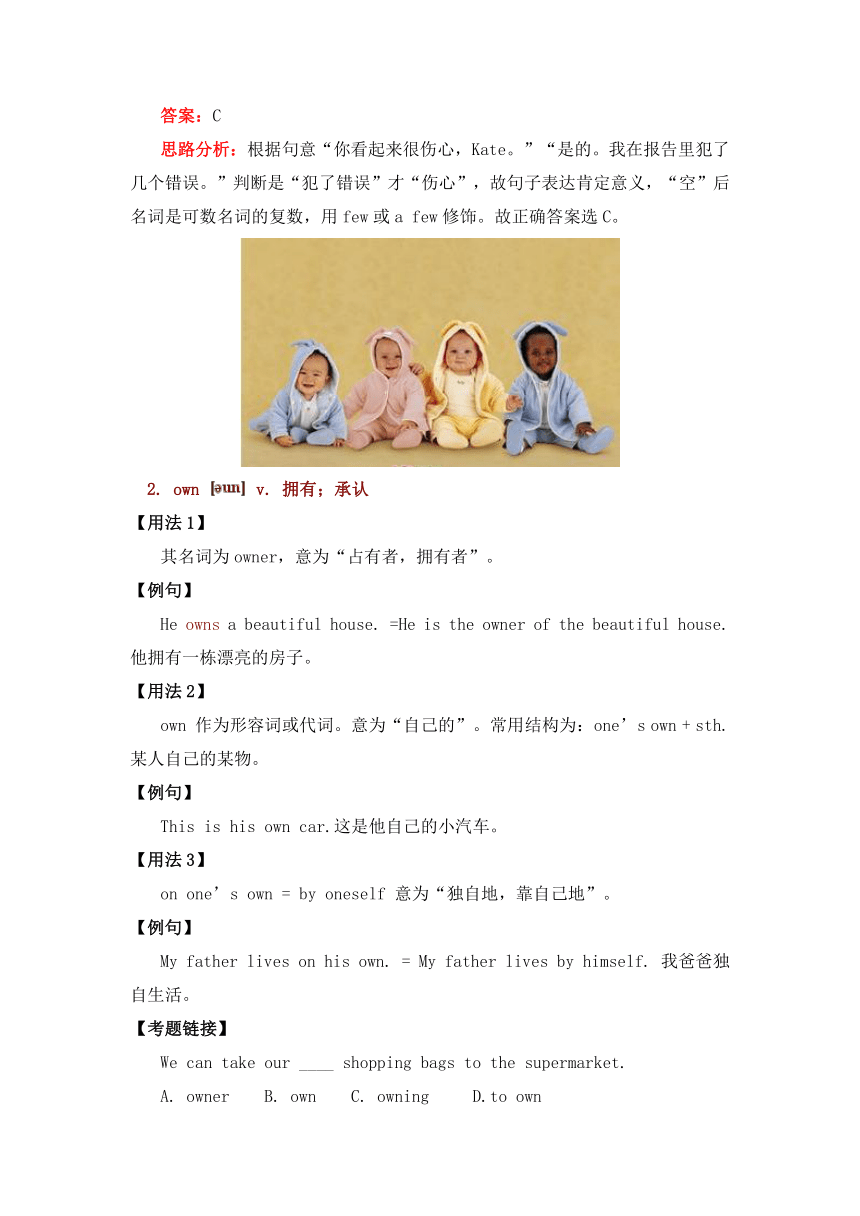
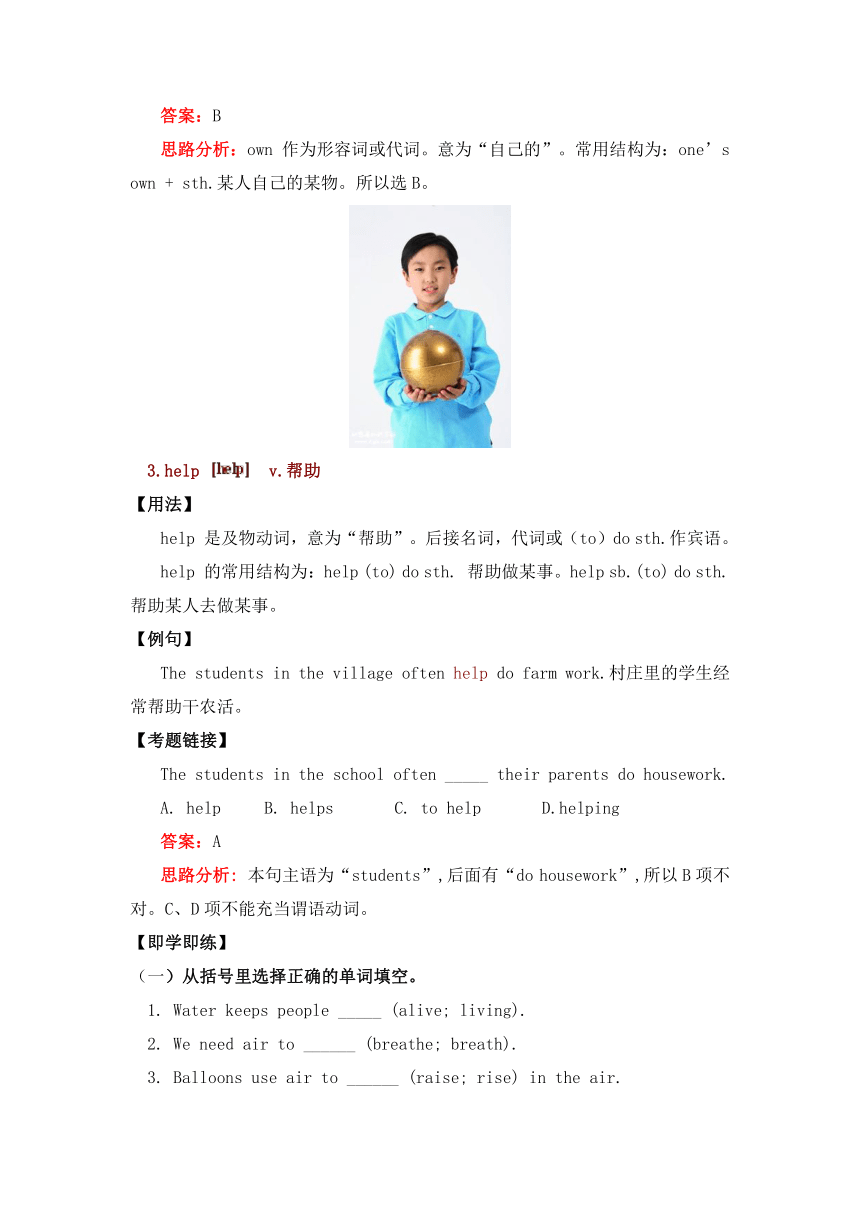
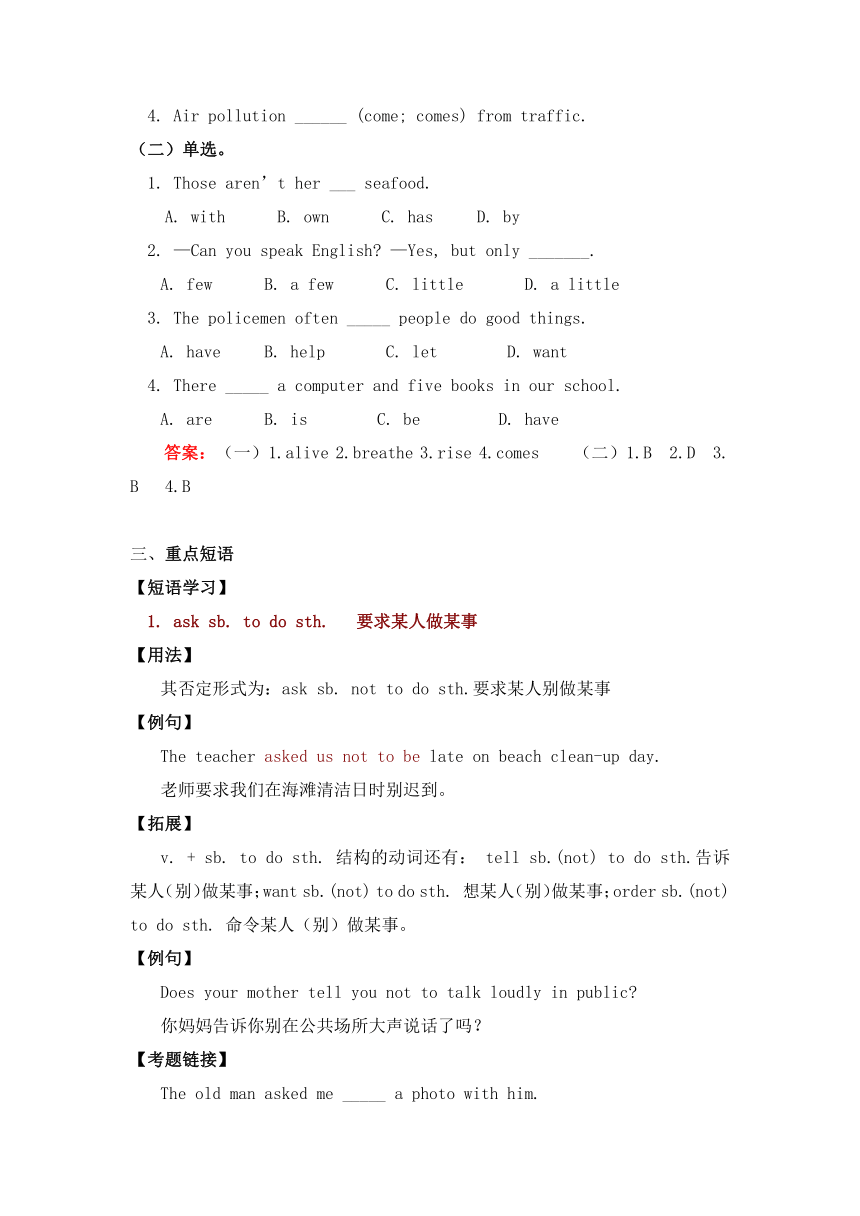
文档简介
年 级 初一 学 科 英语 版 本 牛津深圳版
课程标题 上册M2 Unit 3 The Earth(二)
一、学习目标
1. 能够谈论如何保护地球。
2. 掌握few, a few, little, a little的区别。
3. 了解help后接动词的用法。
4. 能够写关于保护地球的报告。
5. 了解中国关于太阳的神话传说。
二、重点、难点
重点:
1. 单词:few, own, help
2. 短语:ask sb. to do sth.; have a look at; keep sb./sth. +adj.; find out
3. 句型:
1) What is the weather like in different places on Earth?
2) We need air to survive.
3) Air has no taste.
4) It keeps us alive.
难点:
few, a few, little, a little的用法。
知识梳理:
一、单词领读
survive n. 生存 alive adj. 活着的
smell n. 气味 breathe v. 呼吸
poem n. 诗歌 balloon n. 气球
taste n. & v. 味道 & 品尝 lift v. 举起
rise v. 升起,上升 few adj. &porn. 很少的&很少
二、重点单词
【单词学习】
1. few adj. &pron. 很少的&很少
【例句】
—What do you think of George? 你认为乔治是怎样的人?
—He’s a man of few words. He always stays alone.他是个话很少的人。他总是独自呆着。
【考点】
few, a few,little, a little的区别:
few 用来修饰可数名词,表示否定意义,意为“没几个,几乎没有”。 I have few apples. 我没有几个苹果。
a few 用来修饰可数名词,表示肯定意思,意为“有几个”。 There are a few books on the desk.桌上有几本书。
little 用来修饰不可数名词,表否定意思,意为“很少,几乎没有”。 There is little milk in the bottle.瓶中没有多少牛奶了。
a little 用来修饰不可数名词,表示肯定意思,意为“有一点”。 There is a little water in the bowl.碗里有一点水。
【考题链接】
—You look sad, Kate.
—Yeah. I have made ____ mistakes in my report.
A. a little B. little C. a few D. few
答案:C
思路分析:根据句意“你看起来很伤心,Kate。”“是的。我在报告里犯了几个错误。”判断是“犯了错误”才“伤心”,故句子表达肯定意义,“空”后名词是可数名词的复数,用few或a few修饰。故正确答案选C。
2. own v. 拥有;承认
【用法1】
其名词为owner,意为“占有者,拥有者”。
【例句】
He owns a beautiful house. =He is the owner of the beautiful house.他拥有一栋漂亮的房子。
【用法2】
own 作为形容词或代词。意为“自己的”。常用结构为:one’s own + sth.某人自己的某物。
【例句】
This is his own car.这是他自己的小汽车。
【用法3】
on one’s own = by oneself 意为“独自地,靠自己地”。
【例句】
My father lives on his own. = My father lives by himself. 我爸爸独自生活。
【考题链接】
We can take our ____ shopping bags to the supermarket.
A. owner B. own C. owning D.to own
答案:B
思路分析:own 作为形容词或代词。意为“自己的”。常用结构为:one’s own + sth.某人自己的某物。所以选B。
3.help v.帮助
【用法】
help 是及物动词,意为“帮助”。后接名词,代词或(to)do sth.作宾语。
help 的常用结构为:help (to) do sth. 帮助做某事。help sb.(to) do sth. 帮助某人去做某事。
【例句】
The students in the village often help do farm work.村庄里的学生经常帮助干农活。
【考题链接】
The students in the school often _____ their parents do housework.
A. help B. helps C. to help D.helping
答案:A
思路分析: 本句主语为“students”,后面有“do housework”,所以B项不对。C、D项不能充当谓语动词。
【即学即练】
(一)从括号里选择正确的单词填空。
1. Water keeps people _____ (alive; living).
2. We need air to ______ (breathe; breath).
3. Balloons use air to ______ (raise; rise) in the air.
4. Air pollution ______ (come; comes) from traffic.
(二)单选。
1. Those aren’t her ___ seafood.
A. with B. own C. has D. by
2. —Can you speak English? —Yes, but only _______.
A. few B. a few C. little D. a little
3. The policemen often _____ people do good things.
A. have B. help C. let D. want
4. There _____ a computer and five books in our school.
A. are B. is C. be D. have
答案:(一)1.alive 2.breathe 3.rise 4.comes (二)1.B 2.D 3. B 4.B
三、重点短语
【短语学习】
1. ask sb. to do sth. 要求某人做某事
【用法】
其否定形式为:ask sb. not to do sth.要求某人别做某事
【例句】
The teacher asked us not to be late on beach clean-up day.
老师要求我们在海滩清洁日时别迟到。
【拓展】
v. + sb. to do sth. 结构的动词还有: tell sb.(not) to do sth.告诉某人(别)做某事;want sb.(not) to do sth. 想某人(别)做某事;order sb.(not) to do sth. 命令某人(别)做某事。
【例句】
Does your mother tell you not to talk loudly in public?
你妈妈告诉你别在公共场所大声说话了吗?
【考题链接】
The old man asked me _____ a photo with him.
A. take B. taking C. to take D. takes
答案:C
思路分析: ask sb. to do sth. 是固定搭配。所以选C。
2. have a look at sth. 看一看某物
【用法】
have a look at sth.= take a look at sth. ,意为“看一看某物”。have/take a look at sth.与look at 同义,但have/take a look at sth. 更强调动作的发生。
【例句】
May I have/take a look at your new bike? 我能看看你的新自行车吗?
【考题链接】
May I look at your new car?
A. take a look at B. look up C. look out D. look for
答案:A
思路分析: B项“查阅”,C项“当心”,D项“寻找”都不符合题意。
3. keep sb./sth. + adj. 保持某人或某物怎么样
【例句】
Keep the trees green. 保持树为绿色。
【考题链接】
The teacher tells us to keep the classroom _____.
A. clean B. cleaning C. to clean D. cleanly
答案:A
思路分析:B项为doing形式,C项为to do形式, D项为副词,均不符合keep 后加adj的结构。所以选A。
4. find out 找到,发现
【例句】
Please find out his name. 请找出他的名字。
【考点】
look for, find, find out 的区别:
look for 为动词词组,意为“寻找”,强调“寻找找”的过程。 The police looked for the thief everywhere, but they didn’t find him.
警察到处找那位小偷,但没找到。
find 指“偶然发现”或“几乎无困难地找到”。强调“寻找”的结果。 I find my pen under my bed.
我在床下找到我的钢笔。
find out 强调经过一番调查,了解和查询后才弄明白而“找到”。 We must find out a way to protect the Earth.
我们必须找到一条保护地球的方法。
【考题链接】
Lily _____ her shoes, but she didn’t ______ them.
A. looked for; find B. found; looked for
C. looked for; find out D. found out; looked for
答案:A
思路分析:look for强调“寻找”的过程。find强调“寻找”的结果。综上所述,只有A项符合。
【即学即练】
(一)用括号中所给词的适当形式填空。
1. There are _____ fish in the river than before. (few)
2. They are ______ for their mothers. (look)
3. Tom asked his sister _____ her homework. (do)
4. We must keep our room ______. (cleanly)
(二)汉译英。
1. 我可以读懂一张海报去学习关于地球的事情。
_____________________________
2. 后羿把九个太阳从空中射下来了。
___________________________
3. 我们呼吸需要空气。
_____________________
4. 空气让我们活着。
____________________
答案:(一)1.fewer 2.looking 3. to do 4. clean
(二)1. I can read a poster to learn about the Earth. 2. Hou Yi shot nine suns out of the sky. 3. We need air to breathe. 4. Air keeps us alive.
四、重点句型
【句型学习】
1. What is the weather like in different places on Earth? 地球上不同地方的天气如何?
【句析】
这是一个询问天气情况的句式。其中,like 是介词。除此之外,还可以用“How is the weather?”来询问天气。
【例句】
—What’s the weather like today? 今天天气怎么样?
—It’s fine.天晴。
【考题链接】
_______ is the weather like today?
A. How B. What C. Why D. When
答案:B
思路分析:What’s the weather like ...?是固定搭配。
2.We need air to survive.我们需要空气来生存。
【句析】
need作为实义动词,其后面的宾语可以是名词,动名词,动词不定式或代词。在此情况下need可用于肯定句,否定句和疑问句中,构成否定句和疑问句时要借助于助动词do或does。
【例句】
We need a great deal of money now. 我们现在需要很多钱。
They don’t need it any more. 他们不再需要它了。
【注意】
need作为情态动词,没有人称和数的变化。回答由Must引导的一般疑问句时,否定回答用needn’t。当表示某事需要被做时可以用“sth. need(s) doing…”或“sth. need(s) to be done...” 。
【考题链接】
— ____ I type this letter again?
—No, you _______.
A. Need; needn’t B. Must; mustn’t C. Need; don’t D. Must; don’t
答案:A
思路分析: B项的否定回答应该是“needn’t”。C,D项不符合情态动词的用法。
3. Air has no taste. 空气没有气味。
【句析】
no 形容词,意为“没有”。表否定意义。位于单数可数名词前面时,相当于not a (not...a)。
【例句】
The old woman has no child. = The old woman doesn’t have a child.那位老妇人没有孩子。
【拓展】
no位于复数可数名词或不可数名词前面时,相当于not any(not...any)。
【例句】
There is no water on the moon. =There is not any water on the moon.月球上没有水。
【考题链接】
Air has ____ smell.
A. no B. not C. no any D. not some
答案:A
思路分析:A项“no” 为形容词,意为“没有”。表否定意义。位于单数可数名词前面时,相当于not a (not...a)。而B,C,D项不合语法结构。
4. It keeps us alive. 它让我们活在世上。
【句析】
此句结构为“keep sb. /sth. + adj.”,其中alive 为形容词,表“活着的,在世的”,常作表语。
【例句】
The dog is alive. 这只狗是活着的。
【考点】
alive, lively与living的区别:
alive alive 为形容词,表“活着的,在世的”,常作表语,也可作后置定语。 Is the cat alive or dead? 那只猫活的还是死的?
lively lively “活泼的”,常作表语,与active同义。 He is a lively child and popular with everyone.
他是一个活泼的孩子,大家都喜欢他。
living 表示“活着的,在使用的”,常作定语,也可作表语。作表语时与alive意思相同。 All living things need water and air.所有的生物都需要水和空气。
【考题链接】
Mary is a ____ girl and we like her very much.
A. alive B. lively C. living D. live
答案:B
思路分析:A项“活着的”,作表语。C项“活着的”,作定语。D项“居住”,均不符合题意。只有B项“活泼的”,可作定语。
【即学即练】
I. 根据音标和句意写单词。
1. I saw the whole accident with my _______ eyes.
2. We have protected the lake from ______.
3. It is _____ to see that everything goes well.
4. Please ______ the rubbish into the bin.
II. 从方框中选择适当的单词完成句子。
feel lift keep smell breathe rises
The Sun _____ in the east.
I can _____ the wind blowing on my face from an open window.
This box is too heavy for me to ______.
Please _____ the child quiet.
The ____ of the food filld the kitchen.
All living things_____ air.
III.汉译英。
1. 在……起始: 2. 例如: 3. 找出,发现:
4. 不同种类的鱼: 5. 拯救海洋: 6. 变得更凉爽:
答案:I. 1. own 2. pollution 3. important 4. put
II. 1. rises 2. feel 3. lift 4. keep 5. smell 6. breathe
III. 1. at the beginning of 2. for example 3. find out 4. different types of fish 5. save the sea 6. get cooler
课程标题 上册M2 Unit 3 The Earth(二)
一、学习目标
1. 能够谈论如何保护地球。
2. 掌握few, a few, little, a little的区别。
3. 了解help后接动词的用法。
4. 能够写关于保护地球的报告。
5. 了解中国关于太阳的神话传说。
二、重点、难点
重点:
1. 单词:few, own, help
2. 短语:ask sb. to do sth.; have a look at; keep sb./sth. +adj.; find out
3. 句型:
1) What is the weather like in different places on Earth?
2) We need air to survive.
3) Air has no taste.
4) It keeps us alive.
难点:
few, a few, little, a little的用法。
知识梳理:
一、单词领读
survive n. 生存 alive adj. 活着的
smell n. 气味 breathe v. 呼吸
poem n. 诗歌 balloon n. 气球
taste n. & v. 味道 & 品尝 lift v. 举起
rise v. 升起,上升 few adj. &porn. 很少的&很少
二、重点单词
【单词学习】
1. few adj. &pron. 很少的&很少
【例句】
—What do you think of George? 你认为乔治是怎样的人?
—He’s a man of few words. He always stays alone.他是个话很少的人。他总是独自呆着。
【考点】
few, a few,little, a little的区别:
few 用来修饰可数名词,表示否定意义,意为“没几个,几乎没有”。 I have few apples. 我没有几个苹果。
a few 用来修饰可数名词,表示肯定意思,意为“有几个”。 There are a few books on the desk.桌上有几本书。
little 用来修饰不可数名词,表否定意思,意为“很少,几乎没有”。 There is little milk in the bottle.瓶中没有多少牛奶了。
a little 用来修饰不可数名词,表示肯定意思,意为“有一点”。 There is a little water in the bowl.碗里有一点水。
【考题链接】
—You look sad, Kate.
—Yeah. I have made ____ mistakes in my report.
A. a little B. little C. a few D. few
答案:C
思路分析:根据句意“你看起来很伤心,Kate。”“是的。我在报告里犯了几个错误。”判断是“犯了错误”才“伤心”,故句子表达肯定意义,“空”后名词是可数名词的复数,用few或a few修饰。故正确答案选C。
2. own v. 拥有;承认
【用法1】
其名词为owner,意为“占有者,拥有者”。
【例句】
He owns a beautiful house. =He is the owner of the beautiful house.他拥有一栋漂亮的房子。
【用法2】
own 作为形容词或代词。意为“自己的”。常用结构为:one’s own + sth.某人自己的某物。
【例句】
This is his own car.这是他自己的小汽车。
【用法3】
on one’s own = by oneself 意为“独自地,靠自己地”。
【例句】
My father lives on his own. = My father lives by himself. 我爸爸独自生活。
【考题链接】
We can take our ____ shopping bags to the supermarket.
A. owner B. own C. owning D.to own
答案:B
思路分析:own 作为形容词或代词。意为“自己的”。常用结构为:one’s own + sth.某人自己的某物。所以选B。
3.help v.帮助
【用法】
help 是及物动词,意为“帮助”。后接名词,代词或(to)do sth.作宾语。
help 的常用结构为:help (to) do sth. 帮助做某事。help sb.(to) do sth. 帮助某人去做某事。
【例句】
The students in the village often help do farm work.村庄里的学生经常帮助干农活。
【考题链接】
The students in the school often _____ their parents do housework.
A. help B. helps C. to help D.helping
答案:A
思路分析: 本句主语为“students”,后面有“do housework”,所以B项不对。C、D项不能充当谓语动词。
【即学即练】
(一)从括号里选择正确的单词填空。
1. Water keeps people _____ (alive; living).
2. We need air to ______ (breathe; breath).
3. Balloons use air to ______ (raise; rise) in the air.
4. Air pollution ______ (come; comes) from traffic.
(二)单选。
1. Those aren’t her ___ seafood.
A. with B. own C. has D. by
2. —Can you speak English? —Yes, but only _______.
A. few B. a few C. little D. a little
3. The policemen often _____ people do good things.
A. have B. help C. let D. want
4. There _____ a computer and five books in our school.
A. are B. is C. be D. have
答案:(一)1.alive 2.breathe 3.rise 4.comes (二)1.B 2.D 3. B 4.B
三、重点短语
【短语学习】
1. ask sb. to do sth. 要求某人做某事
【用法】
其否定形式为:ask sb. not to do sth.要求某人别做某事
【例句】
The teacher asked us not to be late on beach clean-up day.
老师要求我们在海滩清洁日时别迟到。
【拓展】
v. + sb. to do sth. 结构的动词还有: tell sb.(not) to do sth.告诉某人(别)做某事;want sb.(not) to do sth. 想某人(别)做某事;order sb.(not) to do sth. 命令某人(别)做某事。
【例句】
Does your mother tell you not to talk loudly in public?
你妈妈告诉你别在公共场所大声说话了吗?
【考题链接】
The old man asked me _____ a photo with him.
A. take B. taking C. to take D. takes
答案:C
思路分析: ask sb. to do sth. 是固定搭配。所以选C。
2. have a look at sth. 看一看某物
【用法】
have a look at sth.= take a look at sth. ,意为“看一看某物”。have/take a look at sth.与look at 同义,但have/take a look at sth. 更强调动作的发生。
【例句】
May I have/take a look at your new bike? 我能看看你的新自行车吗?
【考题链接】
May I look at your new car?
A. take a look at B. look up C. look out D. look for
答案:A
思路分析: B项“查阅”,C项“当心”,D项“寻找”都不符合题意。
3. keep sb./sth. + adj. 保持某人或某物怎么样
【例句】
Keep the trees green. 保持树为绿色。
【考题链接】
The teacher tells us to keep the classroom _____.
A. clean B. cleaning C. to clean D. cleanly
答案:A
思路分析:B项为doing形式,C项为to do形式, D项为副词,均不符合keep 后加adj的结构。所以选A。
4. find out 找到,发现
【例句】
Please find out his name. 请找出他的名字。
【考点】
look for, find, find out 的区别:
look for 为动词词组,意为“寻找”,强调“寻找找”的过程。 The police looked for the thief everywhere, but they didn’t find him.
警察到处找那位小偷,但没找到。
find 指“偶然发现”或“几乎无困难地找到”。强调“寻找”的结果。 I find my pen under my bed.
我在床下找到我的钢笔。
find out 强调经过一番调查,了解和查询后才弄明白而“找到”。 We must find out a way to protect the Earth.
我们必须找到一条保护地球的方法。
【考题链接】
Lily _____ her shoes, but she didn’t ______ them.
A. looked for; find B. found; looked for
C. looked for; find out D. found out; looked for
答案:A
思路分析:look for强调“寻找”的过程。find强调“寻找”的结果。综上所述,只有A项符合。
【即学即练】
(一)用括号中所给词的适当形式填空。
1. There are _____ fish in the river than before. (few)
2. They are ______ for their mothers. (look)
3. Tom asked his sister _____ her homework. (do)
4. We must keep our room ______. (cleanly)
(二)汉译英。
1. 我可以读懂一张海报去学习关于地球的事情。
_____________________________
2. 后羿把九个太阳从空中射下来了。
___________________________
3. 我们呼吸需要空气。
_____________________
4. 空气让我们活着。
____________________
答案:(一)1.fewer 2.looking 3. to do 4. clean
(二)1. I can read a poster to learn about the Earth. 2. Hou Yi shot nine suns out of the sky. 3. We need air to breathe. 4. Air keeps us alive.
四、重点句型
【句型学习】
1. What is the weather like in different places on Earth? 地球上不同地方的天气如何?
【句析】
这是一个询问天气情况的句式。其中,like 是介词。除此之外,还可以用“How is the weather?”来询问天气。
【例句】
—What’s the weather like today? 今天天气怎么样?
—It’s fine.天晴。
【考题链接】
_______ is the weather like today?
A. How B. What C. Why D. When
答案:B
思路分析:What’s the weather like ...?是固定搭配。
2.We need air to survive.我们需要空气来生存。
【句析】
need作为实义动词,其后面的宾语可以是名词,动名词,动词不定式或代词。在此情况下need可用于肯定句,否定句和疑问句中,构成否定句和疑问句时要借助于助动词do或does。
【例句】
We need a great deal of money now. 我们现在需要很多钱。
They don’t need it any more. 他们不再需要它了。
【注意】
need作为情态动词,没有人称和数的变化。回答由Must引导的一般疑问句时,否定回答用needn’t。当表示某事需要被做时可以用“sth. need(s) doing…”或“sth. need(s) to be done...” 。
【考题链接】
— ____ I type this letter again?
—No, you _______.
A. Need; needn’t B. Must; mustn’t C. Need; don’t D. Must; don’t
答案:A
思路分析: B项的否定回答应该是“needn’t”。C,D项不符合情态动词的用法。
3. Air has no taste. 空气没有气味。
【句析】
no 形容词,意为“没有”。表否定意义。位于单数可数名词前面时,相当于not a (not...a)。
【例句】
The old woman has no child. = The old woman doesn’t have a child.那位老妇人没有孩子。
【拓展】
no位于复数可数名词或不可数名词前面时,相当于not any(not...any)。
【例句】
There is no water on the moon. =There is not any water on the moon.月球上没有水。
【考题链接】
Air has ____ smell.
A. no B. not C. no any D. not some
答案:A
思路分析:A项“no” 为形容词,意为“没有”。表否定意义。位于单数可数名词前面时,相当于not a (not...a)。而B,C,D项不合语法结构。
4. It keeps us alive. 它让我们活在世上。
【句析】
此句结构为“keep sb. /sth. + adj.”,其中alive 为形容词,表“活着的,在世的”,常作表语。
【例句】
The dog is alive. 这只狗是活着的。
【考点】
alive, lively与living的区别:
alive alive 为形容词,表“活着的,在世的”,常作表语,也可作后置定语。 Is the cat alive or dead? 那只猫活的还是死的?
lively lively “活泼的”,常作表语,与active同义。 He is a lively child and popular with everyone.
他是一个活泼的孩子,大家都喜欢他。
living 表示“活着的,在使用的”,常作定语,也可作表语。作表语时与alive意思相同。 All living things need water and air.所有的生物都需要水和空气。
【考题链接】
Mary is a ____ girl and we like her very much.
A. alive B. lively C. living D. live
答案:B
思路分析:A项“活着的”,作表语。C项“活着的”,作定语。D项“居住”,均不符合题意。只有B项“活泼的”,可作定语。
【即学即练】
I. 根据音标和句意写单词。
1. I saw the whole accident with my _______ eyes.
2. We have protected the lake from ______.
3. It is _____ to see that everything goes well.
4. Please ______ the rubbish into the bin.
II. 从方框中选择适当的单词完成句子。
feel lift keep smell breathe rises
The Sun _____ in the east.
I can _____ the wind blowing on my face from an open window.
This box is too heavy for me to ______.
Please _____ the child quiet.
The ____ of the food filld the kitchen.
All living things_____ air.
III.汉译英。
1. 在……起始: 2. 例如: 3. 找出,发现:
4. 不同种类的鱼: 5. 拯救海洋: 6. 变得更凉爽:
答案:I. 1. own 2. pollution 3. important 4. put
II. 1. rises 2. feel 3. lift 4. keep 5. smell 6. breathe
III. 1. at the beginning of 2. for example 3. find out 4. different types of fish 5. save the sea 6. get cooler
